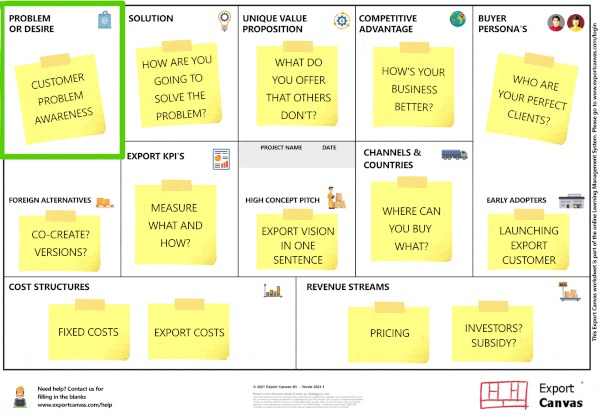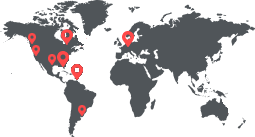
80
The profit is determined by your international value proposition
Develop a profitable export plan
Exporting to another country often entails unexpected costs. You must take this into account when considering how to build a profitable export plan. For example, do you use a forwarder or an agent? Do you choose to open your own sales office?
On the revenue side, how you will market your product or service is an important consideration. Are customers abroad the same customer as customers in your home country? Do they have different wishes, requirements and expectations for your product? Your advisor uses Export Canvas to help you your personalized export plan. You map out your international goals with 12 building blocks in 12 topics. Export goods, knowledge services? Together with another advisor, you will consider your revenue model, added value, customers, relations, and suppliers.
Components of an Export Plan
What are the strong and weak points of your story? Do you want increased revenue, or just improved margins through higher volume? Do you want to replace clients you lost during the crisis? Or do you want to grow in a specific market? With the right questions and answers, your Export Business Model Canvas will contribute to clarifying your goals.
- Step 1: Market Definition
Market definition determines the direction of your export strategy and usually contains several dimensions, such as products, customer groups, and needs. In this step you take a close look at your prospective market. - Step 2: Internal Analysis
Is the company financially capable of broadening or developing their market? A financial ratio analysis is indispensable. Alongside the financial approach you should analyze both your organization and your products. - Step 3: Export Country Selection
Which country is the best to start selling your products? First, focus on a few potential interesting export markets. Then determine which ones you are going to tackle (initially). - Step 4: Industry Analysis
The most important questions for the exporter to ask involve how the make developments in your industry in the chosen target country. Once those are answered, you can look at opportunities and threats in the industry and learn how export companies can position themselves within the markets. - Step 5: Competitive Analysis
How does your product differentiate itself from competitive products? It is important to identify current and/or their distinctive qualities. You design a competitive analysis based on how you define your competition. - Step 6: Customer Analysis
Then, you have chosen a few countries, with the help of your filter model, you determine which contain attractive segments that are homogeneous with your marketing policy. - Step 7: Distribution Analysis
To answer questions of how the to best approach the foreign market, analysis of means of enty and associated possibilities is necessary. You list and compare the pros and cons of the potential channels. - Step 8: Confrontation Matrix
After internal and external analysis you compile a confrontation matrix. You will formulate several options for successfully realizing success in the country/market. You will set your growth strategy, determine your market and identify your market entry strategy. - Step 9: Export Marketing Policy
Why should a foreign client buy this product or service and why from you? In this step you will refine your four Ps of your marketing mix. - Step 10: Your plan’s financial feasibility
In this last step you consider the extent of your financial risk and actions that can to be taken to increase your plan’s feasibility.
Export Canvas forms the basis of your Export Plan and facilitates its further development.


Develop a profitable export plan
- Choose a location for sales.
It is critical to conduct research. With a bit of desk research, you can identify the markets. You will find consumption and import data on similar products, as well as data on the pace of economic growth in a potential new market. You will investigate demographics, cultural and religious customs, and possible competitors. - Build a strategy.
First, you should always include your people in your export strategy.
Your workers.
Can someone from your team to lead the program, or do you need to hire someone new?
Your Capacity.
Is it adequate to handle the demands of a new market? Do you need to upgrade?
Your Product packaging.
Will the style of your package appeal to your new target market? Does the law require you to label items differently, or do your labels need translating?
Your Expertise.
Pay a visit to your prospective new market. Showcase your items at trade shows and network with new people. - Select a marketing strategy.
Four options are available to you.
1. Make direct sales.
2. Work with a distributor.
3. Hire a salesperson.
4. Form a joint venture with another company.
Whichever strategy you choose, you must be sure that responsibility for delivery and payment is clearly defined and understood. In addition, ALWAYS remember to protect your intellectual property. - Look for opportunities.
One of the most reliable ways to uncover possibilities in both the Europe and overseas is to attend trade shows. Meet potential clients and develop new business. Consult us about possible funds to help defray the costs of showing, or consider splitting the cost of a booth with another company. - Begin marketing.
Advertisements can help you obtain exposure, but they can be costly. Keep in mind the target demographic and the cost vs. return on investment, just as you would in the Europe. An alternative is to construct a website with material translated in the target market’s native language. Global social media platforms like LinkedIn, Facebook, and Twitter can also assist you in quickly and cost-effectively promoting your message. - Be aware of administrative procedures.
You must complete specific administrative requirements correctly from the start. Consulates and Embassies in the USA will assist you in understanding the customs registration, forms, and payment procedures.
Exporting is all about documentation; without it, there would be no contract, no transportation, and payment. The requirements differ from one country to the next. - Consider legal issues.
It’s critical to understand the legal and regulatory environments in the target countries. We can assist you with all the paperwork and can also put you in touch with international lawyers if necessary.
Are your product compliance certificates and liability insurance valid in other countries?
Examine your intellectual property rights and trademark registrations. - Transportation logistics.
Now that you’ve made the sale and agreed on the terms, you need to deliver the products! We can assist you in making sense of your transportation options. From Incoterms to insurance to tariffs and customs clearance to packaging, and the mode(s) of transport or freight forwarders, we’ve got you covered.






